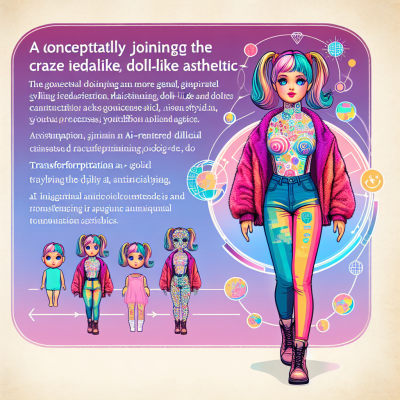
The Rise of Barbiecore: Why the World Is Obsessed with AI-Generated Dolls of Public Figures
In a cultural moment where nostalgia meets cutting-edge technology, the Barbiecore trend is taking yet another unexpected twist. With artificial intelligence now able to convert public figures into flawless, plastic-fantasy versions of themselves, the internet is buzzing with pixel-perfect images of world leaders and celebrities reimagined as miniature dolls. From Donald Trump and Elon Musk to Keir Starmer, no influential figure is safe from being transformed into a glammed-up, glossy toy.
Welcome to the era of AI-generated doll avatars—where the political meets the playful, and social media can’t get enough.
What Is Barbiecore?
Barbiecore is more than a fashion trend—it’s a cultural phenomenon. Inspired by the iconic Mattel doll, Barbiecore celebrates hyper-femininity, bold pastel colors, and glamorous aesthetics. While originally rooted in fashion—think vibrant pink clothing, coordinated accessories, and vintage Barbie vibes—the trend has now expanded well beyond the wardrobe.
Now, with the help of AI, Barbiecore has a digital twist: anyone, even world leaders, can be turned into idealized toy replicas that embody the essence of this flamboyant trend.
AI Meets Imagination: The Tech Behind the Dolls
This latest wave of Barbiecore madness is driven by advancements in AI-driven image generation. Using sophisticated machine learning models, artists and content creators are able to produce hyper-realistic, stylized images of well-known personalities as dolls. These tools not only replicate facial features with startling accuracy but also reimagine attire, accessories, and entire backdrops—giving every AI-generated doll a polished, Barbie-like aesthetic.
Popular AI Tools Used:
- Midjourney – Known for its ultra-stylized visual outputs
- DALL·E – Ideal for whimsical reinterpretations
- Artbreeder – Used for realistic facial amalgamations
These tools allow users to manipulate everything from facial structure to clothing elements, fitting any individual into Barbie’s glitzy universe.
From White House to Dollhouse: Public Figures Reimagined
The image circulating online (shown above) displays an uncanny, doll-like rendering of figures like Donald Trump, Elon Musk, and Keir Starmer. These transformations turn powerful men into pint-sized, stylized versions of themselves—complete with glossy hair, plastic smiles, and tailored pink ensembles.
This not only highlights how AI is reshaping digital creativity, but it also invites commentary on society’s fascination with fame, power, and the idealized self. Seeing influential leaders turned into toys speaks volumes about how technology can democratize image-making and subvert age-old perceptions of authority.
Why People Love It:
- It’s humorous and irreverent – People enjoy seeing powerful figures in playful, unexpected formats.
- It empowers creativity – Both artists and casual users can participate in this identity-recasting trend.
- Nostalgia meets novelty – Merging childhood memories with contemporary tech fuels emotional engagement.
Social Media: The Playground for Barbiecore AI Art
Platforms like Instagram, Reddit, and Twitter are flooded with posts of AI-born Barbie-inspired characters. Influencers, content creators, and everyday users are not just sharing these doll versions of celebrities but creating their own—spinning entire narratives around AI-generated personas.
Hashtags like #BarbiecoreAI and #AIDolls are trending, with thousands of users contributing to the growing library of fantastical reimaginings. The trend has become so viral that some people have even turned their AI-generated dolls into merchandise—from stickers and phone cases to collectible digital art NFTs.
The Cultural Impact of AI-Driven Barbiecore
This digital trend might seem lighthearted on the surface, but it carries deeper interpretive layers. It poses questions about identity, perfection, and representation in the new digital age.
Key Cultural Takeaways:
- Self-Image and Perception: What does it mean to see ourselves or our leaders as toys?
- Power and Play: Can playfulness disarm or humanize people in positions of power?
- Tech and Art’s Convergence: The trend underscores how AI is becoming a legitimate tool for cultural production.
In a world where technology rapidly evolves how we see ourselves and others, Barbiecore in its AI form is a perfect blend of innocence and intellect—a pop culture statement for the digital generation.
Final Thoughts
The AI-generated Barbiecore craze encapsulates the intersection of nostalgia, imagination, and technological prowess. Whether it’s Elon Musk striking a pose on a plastic podium or Keir Starmer with glimmering doll eyes, the trend reflects our collective desire to blend fantasy with reality—however whimsically.
As tools become more accessible and creativity more boundaryless, expect to see more public figures and even ordinary people embracing their doll alter egos.
So will you join the millions swept up in the Barbiecore fever, or resist the call of the digital dollhouse? Either way, the AI-powered toy revolution is here—and it’s image-perfect.


Leave a Reply